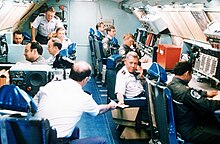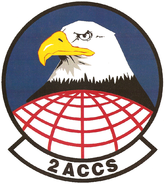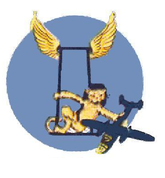2nd Airborne Command and Control Squadron
2nd Airborne Command and Control Squadron
 |
|
|---|---|
 |
|
| Active | 1942-1944; 1949-1952; 1952-1954; 1970-1994 |
| Country |
|
| Branch |
|
| Role | Command and control |
| Part of | Strategic Air Command |
| Decorations | Air Force Outstanding Unit Award |
| Insignia | |
| 2d Airborne Command and Control Squadron emblem |  |
| 2d Ferrying Squadron emblem |  |
The United States Air Force's 2d Airborne Command and Control Squadron was an airborne command and control unit located at Offutt Air Force Base, Nebraska. The squadron was an integral part of the United States' Post Attack Command and Control System, performing the Operation Looking Glass mission with the Boeing EC-135 aircraft.
From its activation in April 1942 until it was disbanded in 1944, the 2d Ferrying Squadron received aircraft at their factory of origin and ferried them to the units to which they were assigned.
The 2d Liaison Squadron provided emergency air evacuation, search and rescue, courier and messenger service, routine reconnaissance and transportation of personnel. It regularly operated between Langley Air Force Base, Virginia and Fort John Custis with one Beechcraft C-45 Expeditor and several Stinson L-13s.
In July 1952, the squadron closed at Langley and reopened at Shaw Air Force Base, South Carolina, operating de Haviland Canada L-20 Beavers. It operated a regular courier service to Pope Air Force Base, North Carolina and Myrtle Beach Air Force Base, South Carolina. In 1953, the squadron also began operating Sikorsky H-19 helicopters. The unit was inactivated in June 1954.
The desire for an Airborne Command Post (ABNCP) to provide survivable command and control of Strategic Air Command's nuclear forces came about in 1958. By 1960, modified KC-135A command post aircraft began pulling alert for SAC under the 34th Air Refueling Squadron (AREFS). On 3 February 1961, Continuous Airborne Operations (CAO) commenced, which meant that there was always at least one Looking Glass aircraft airborne at all times. Starting in 1966, the 38th Strategic Reconnaissance Squadron took over the Looking Glass mission. Eventually, on 1 April 1970, the 2nd ACCS took over the Looking Glass mission flying EC-135C ABNCP aircraft for the duration of the Cold War as a critical member in the Post Attack Command and Control System. There continued to be at least one Looking Glass aircraft airborne at all times providing a backup to SAC's underground command post. Additionally, the 2 ACCS maintained an additional EC-135C on ground alert at Offutt AFB, NE as the EASTAUXCP (East Auxiliary Command Post), providing backup to the airborne Looking Glass, radio relay capability, and a means for the Commander in Chief of SAC to escape an enemy nuclear attack.
...
Wikipedia
